
Manufacturer's Specifications
System Type: Two-way, acoustic suspension system.
Drivers: 6-in. cone woofer and 3/4-in. soft-dome tweeter.
Frequency Response: 65 Hz to 20 kHz, +0,-3 dB.
Sensitivity: 88 dB at 1 meter with 2.83 V rms applied.
Crossover Frequency: 3.6 kHz.
Impedance: 8 ohms nominal, 5 ohms minimum.
Recommended Amplifier Power: 10 to 100 watts per channel.
Dimensions: 10 5/8 in. H x 7 3/4 in. W x 11 1/4 in. D (27 cm x 19.7 cm x 28.6 cm); footprint, 7 3/4 in. x 8 1/4 in. (19.7 cm x 21 cm).
Finish: Charcoal-gray vinyl wrap.
Weight: 24 lbs. (11 kg) per pair.
Price: $269 per pair; 28-in.-high stands, $70 per pair.
Company Address: 303 Turnpike St., Canton, Mass. 02021, USA.

Acoustic Research has been in the home loudspeaker business longer than most other speaker manufacturers.
The company was founded by Edgar Villchur in 1954 and first marketed systems based on the acoustic-suspension principle that Villchur invented. The classic three-way AR-3 system, which was introduced in 1958, was the first system of use dome drivers for midrange and tweeter. The bookshelf loudspeaker format and driver configuration was essentially invented by AR, and is the format used by most home loudspeakers to this day.
Since late 1989, Acoustic Research has been operating under the International Jensen umbrella, along with several other companies including Advent, Phase Linear, Now Hear This (NHT), and of course Jensen. From 1967 to 1989 Acoustic Research was owned by Teledyne, Inc. Recently AR formed an alliance with the high-end audio equipment manufacturer Cello to market an affordably priced line of systems with near high-end performance. This came about due to Cello's founder Mark Levinson being very impressed with the sound of the M1 when driven by his Cello amps.
The M1 is the smallest member of AR's Holographic Imaging series of home systems. The series consists of six systems, ranging from the small, two-way M1 up to the three-way, floor-standing M6. All of these systems share the distinctive feature of having a midrange/woofer mounted on a slanted-back baffle, with a tweeter mounted below, offset to one side of the cabinet. All have narrow baffles that minimize diffraction and broaden coverage.
The cabinets of the three smallest systems--the M1, M2, and M3--have very few right angles in their construction.
Their rear panels and tweeter baffles are angled backward at 15° from vertical. The woofer baffle is tilted back even more, by 10°, making a total of 25°. A side view of the system emphasizes these striking features. The speakers' sloping rear and front panels make them look as if they might fall over backwards! All the systems in the line are finished in a somewhat industrial (but good-looking) charcoal-gray vinyl wrapped around medium-density fiberboard. The fit and finish of the reviewed M1 samples were excellent. The tweeter is mount ed to one side below the woofer, on a molded plastic bezel.
The bezel acts both as a mount for the tweeter and as an attractive louvered protective cover, precluding the need for a separate tweeter grille. Because the tweeter is mounted asymmetrically on the bottom front of the cabinet, the systems are supplied in mirror-imaged pairs. A removable, black fabric-covered plastic frame is used to cover the woofer. A good-looking black molded plastic mounting ring covers the woofer frame. The systems looked quite good even with the wooer grille removed.
The odd shape of the box strengthens the assembly, minimizing potential panel resonances. In addition, the nonparallel cabinet walls reduce internal standing waves. The system's small size minimizes these two problems as well.
The Ml's long-excursion, vented-pole woofer uses a polypropylene cone filled with carbon and mica, mounted by a butyl-rubber surround in a stamped-frame basket. The 3 inch, wide-dispersion tweeter has a soft fiber dome and Ferrofluid cooling. The crossover is a simple high-pass network; instead of a low-pass network, the system takes advantage of the woofer's upper roll-off. This is done to "reduce power loss and ensure the smoothest sound," according to AR. AR states that the systems should be set up with their tweeters on the outside and that they should face straight ahead rather than being toed in toward centrally seated listeners. With this orientation, the listener is actually 15° to 20° off each system's horizontal axis. The gentle 25° upward woofer angle tends to project the upper midrange frequencies toward the ceiling. According to AR, this "projects smooth, flat sound at the critical crossover point directly toward your ear and ample hall-simulating midrange reverberation throughout the reflected sound." The company also states that "the asymmetrical offset of the tweeter on its baffle improves imaging over a wider listening angle." Read on to find out how well the speaker delivered on each of these promises.
Measurements
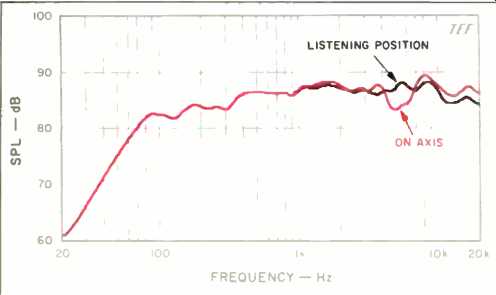
Fig. 1--One-meter, anechoic frequency response, taken on axis and 20° inside
the horizontal axis, for an input of 1 watt into 8 ohms (2.83 V rms).
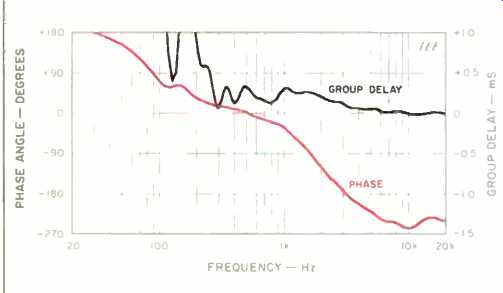
Fig. 2--On-axis phase response and group delay, corrected for tweeter arrival
time.
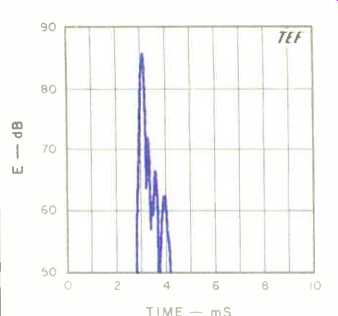
Fig. 3--One-meter, on-axis, energy/time curve.
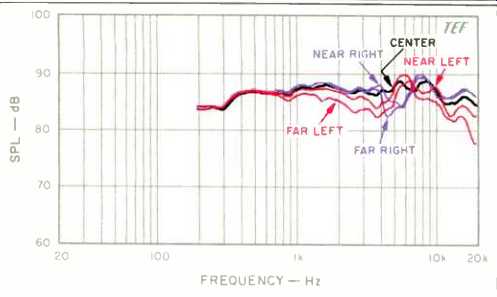
Fig. 4--Frequency response for right channel at five listening positions
in horizontal plane, in 10° increments from 40° off axis ("Far Left"),
through 20° off axis ("Center"), to on-axis ("Far Right").
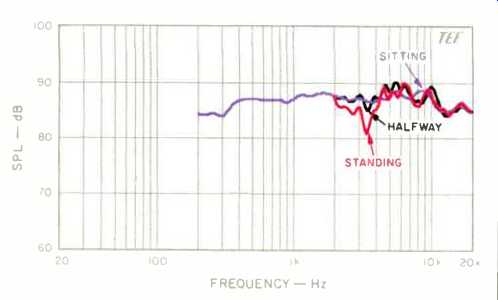
Fig. 5--Frequency response for three listening positions in the vertical
plane.
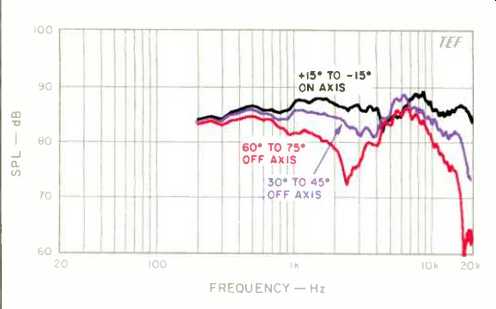
Fig. 6--Mean horizontal responses.
Figure 1 shows the anechoic, equivalent 1-meter frequency response, smoothed with a 10th-octave filter, for 2.83 V rms input (1 watt into the rated 8 ohms). The curves were taken with the microphone even with the top of the cabinet.
This height roughly corresponds to the ear height of a seated listener when the systems are placed on the manufacturer's optional stands. Both free-space and ground plane measurement techniques were used.
The manufacturer's literature was somewhat unclear on the mounting height. The owner's manual stated that the tweeter should be "at around" ear height, which is higher than the systems' position when placed on the optional 28 inch stands (not pictured). I opted to test them at the stand mounted height.
Two curves are shown, one with the microphone directly in front of the box, and the other with the microphone 20° off the horizontal axis in the direction away from the tweeter.
This latter position corresponds approximately to that of a centered listener when the systems are aimed straight ahead, as AR recommends.
The grille, which covers the woofer only, affected the woofer's response in the upper range by less than ± 1 dB (not shown). All measurements were taken with the woofer's grille removed.
The on-axis curve exhibits some roughness above 4 kHz, chiefly a dip from 5 to 6 kHz and a peak at 8 kHz. In contrast, the curve for the listening position is significantly smoother and fits within a fairly tight window of ±2.3 dB from 160 Hz to 20 kHz. Both curves exhibit a gently rising characteristic between 80 Hz and 2 kHz and a 12-dB/octave roll-off below 80 Hz. Averaging the response over the range from 250 Hz to 4 kHz yielded a sensitivity of 86.6 dB, which was slightly lower than the manufacturer's 88-dB rating. The two systems were closely matched, within ±0.75 dB from 200 Hz to 20 kHz.
Figure 2 shows the axial phase and group-delay measurements of the system, corrected for the tweeter's arrival.
The phase response exhibits a fairly low 230° phase rotation between 1 and 20 kHz. The group-delay curve indicates that the woofer lags the tweeter by about 0.23 mS, which is about 0.8 wavelength at the 3.6-kHz crossover. This delay is due partly to physical offset between the acoustic centers of the woofer and tweeter and partly to delays generated by the crossover network.
Figure 3 shows the energy/time curve (ETC) of the M1.
The main arrival, at 3 mS, is quite compact, broadening only below 72 dB SPL, with two lower level peaks at 66 and 62 dB SPL. A perfect ETC would appear as a single sharp spike centered at 3 mS, with a width of about 1 mS at the base (50-dB line) and tapering to a rounded point at the top.
Removing the woofer revealed a close-fitting, well-constructed box made of 5/8-inch-thick medium-density fiberboard. No braces are used for internal strengthening, as the small size and non-right-angle construction of the enclosure minimizes the need for them. The inside of the box was completely stuffed with cotton batting.
A high-level sine-wave sweep revealed moderate side wall resonances of the top, sides, and back in the range from 330 to 360 Hz. Commendably, the woofer did not exhibit any dynamic offset effects. The woofer's linear excursion capability was a healthy 0.25 inch peak to peak, with an excursion limit of about 0.55 inch peak to peak. The woofer overloaded quite gracefully at high levels, with no objectionable noises.
The M1's minimalist crossover consists only of a second order high-pass filter on the tweeter. The filter network, which is wired directly to the input terminals, consists of a ferrite-core inductor and a high-quality, 100-V capacitor of metallized polyester film. Short lengths of stranded 20 gauge hookup wire, attached to the drivers with clips, make up the internal driver connections.
Because of the M1's asymmetrical horizontal and vertical coverage, I have chosen to present response curves at significant points in the listening area rather than my usual "3-D" off-axis response curves. These points correspond to locations spread out horizontally and vertically in the normal listening region.
Figure 4 shows the horizontal coverage of the M1 at angles corresponding to five lateral positions about equally spaced across the normal listening area and corresponding to seating positions on an imaginary couch, 10 feet from the speakers, whose width is equal to the distance between the speakers. It is assumed that only the right-channel system is operating, that its tweeter is on the side away from the center of the listening area, and that it's aimed directly ahead with no inward angling. The measurement points represent listening locations directly in front of the right channel system ("Far Right"), about 10° off axis ("Near Right"), at the center of the couch ("Center"--about 20° off axis), about 30° off axis ("Near Left"), and extending 40° off axis to a point directly in front of the left-channel speaker ("Far Left"). The curves in Fig. 4 show that the smoothest response is, properly, at the center listening position. At points to the right, closer to the driven speaker's axis, the response shows the dip between 5 and 6 kHz and the 8-KHz peak seen in Fig. 1. To the left of the center position, farther off the driven speaker's axis, the response shows a depression between 1 and 5 kHz and a 6-kHz peak, then rolls off above 10 kHz.
Figure 5 shows response curves at three vertical angles--corresponding to sitting, halfway up, and standing-at a location midway between the systems (center of the imaginary couch). These angles correspond roughly to elevations of 0°, 6.5°, and 13° (heights of 36, 50, and 64 inches, at the 10-foot listening distance). In general, these curves are fairly well behaved, except for a 3.5-kHz dip at crossover at the standing position.
Figures 6 and 7 show the NRC-style mean horizontal and vertical on- and off-axis response curves of the M1. In contrast to the previous two figures, which emphasized the M1's operation when aimed straight ahead and heard from 20° off axis, these curves illustrate the system's output within ± 15° of the axis (the standard measurement angle) and at greater off-axis angles.
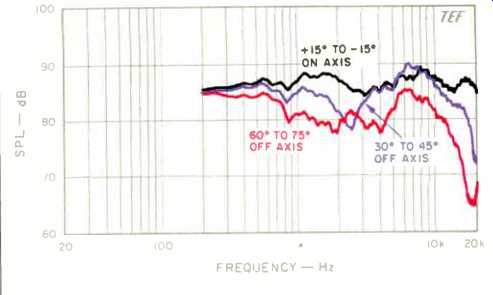
Fig. 7-Mean vertical responses.
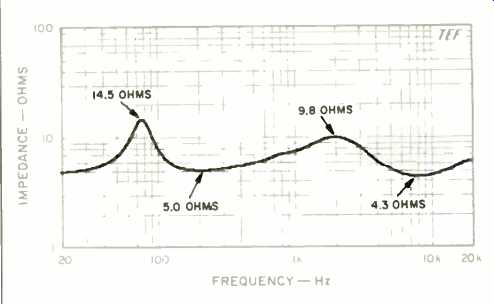
Fig. 8--Impedance.
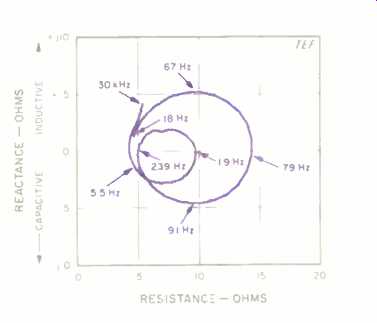
Fig. 9--Complex impedance, showing reactance and resistance vs. frequency.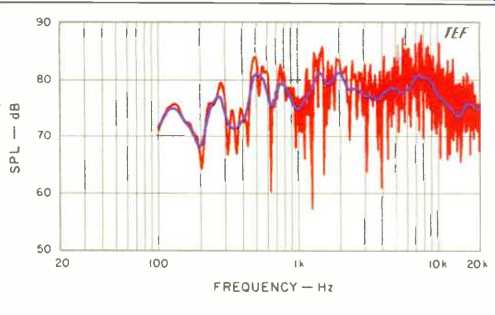
Fig. 10--Three-meter room response, showing both raw and smoothed data.

Fig. 11--Harmonic distortion products for the musical tone B1 (61.7 Hz).
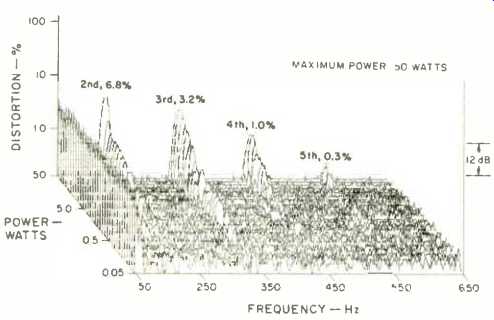
Fig. 12--Harmonic distortion products for the musical tone A2 (110 Hz).
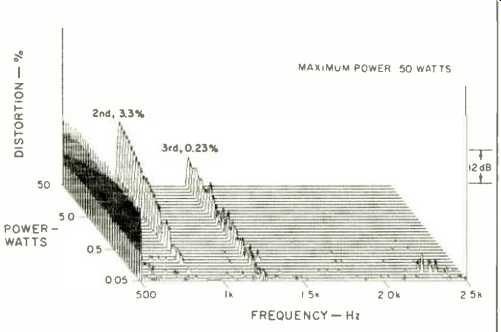
Fig. 13--Harmonic distortion products for the musical tone A4 (440 Hz).
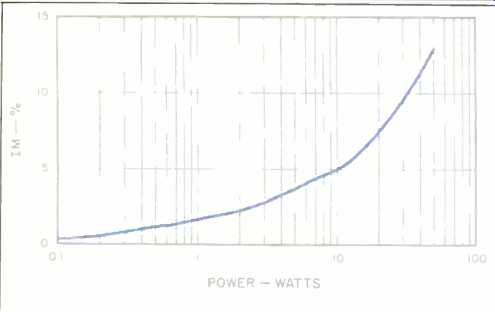
Fig. 14--IM distortion on 440 Hz (A4) produced by 61.7 Hz (B1), mixed in
one-to-one proportion.
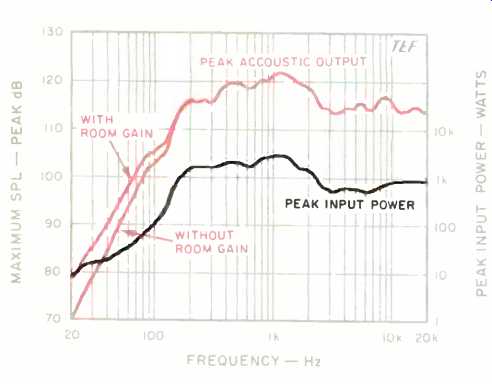
Fig. 15--Maximum peak input power and maximum peak sound output vs. frequency
at 1 meter on axis.
The tweeter's off-center mounting creates interference patterns in the horizontal plane very similar to those found in the vertical plane of most systems. As a result, the mean axial (± 15°) horizontal response curve in Fig. 6 shows the M1's by-now familiar dip at about 5 kHz and rise between 5.5 and 9 kHz. The 30° to 45° response exhibits greater high-frequency attenuation coupled with a broader dip between 2 and 5 kHz. The 60° to 75° off-axis response has a very significant dip at 2.5 kHz along with a rapid roll-off above 8 kHz.
Figure 7 shows the mean vertical responses of the M1.
The mean axial curve (± 15°) fits within a fairly tight window of ±2.3 dB from 200 Hz to 20 kHz, with three peaks and two dips. The 30° to 45° response shows a substantial dip at 2.5 kHz coupled with high-frequency roll-off above 10 kHz. The 60° to 75° response exhibits a broad depression between 800 Hz and 5 kHz and even greater high-frequency roll-off above 10 kHz.
The Ml's impedance is shown in Fig. 8. The curve is quite typical for a closed-box, two-way system and shows no particular problems. The minimum impedance of 4.3 ohms at 8 kHz will not be a problem for any amplifier. The 14.5 ohm peak at 79 Hz indicates the resonant frequency of the closed-box system design, below which the response rolls off at 12 dB/octave. The reasonably low minimum impedance, and the fairly low minimum/maximum impedance ratio of 3.4, make the M1s only somewhat sensitive to cable resistance. To keep cable-drop effects from causing response peaks and dips greater than 0.1 dB, total cable series resistance should be limited to a maximum of about 71 milliohms. This means that cable no smaller than about 16 AWG should be used for a typical 10-foot run.
Figure 9 shows the complex impedance of the M1. No problems are evident. The impedance phase angle (not shown) reached a maximum of only +32° at 60 Hz and a minimum of -29° at 100 Hz, both symmetrical about the closed-box system's low-frequency resonance.
Figure 10 shows the 3-meter room curve of the system, including both raw and sixth-octave smoothed responses.
The M1 was located in the right-hand stereo position with the tweeter on the outside, aimed directly ahead (axis parallel to side wall). The test microphone was placed at ear height (36 inches), at the central listening position on the sofa. The system was swept from 100 Hz to 20 kHz with a sine-wave signal of 2.83 V rms. The parameters of the test sweep were chosen to include the direct sound plus 13 mS of the room's reverberation. The smoothed curve is somewhat rough but does fit within a relatively close envelope of about ±3 dB from 450 Hz to 20 kHz. The curve exhibits a high-frequency rise between 7 and 9 kHz, followed by a moderate roll-off at higher frequencies. The usual room effect response roughness is evident below 1.5 kHz.
Harmonic distortion measurements of the musical notes B1 (61.7 Hz), A2 (110 Hz), and A4 (440 Hz) with increasing power level are shown in Figs. 11, 12, and 13. Figure 11 shows the harmonic distortion data for 61.7 Hz (B1). This tone was used instead of the usual 41.2-Hz (E,) tone because that frequency was below the system's cutoff, as a quick check of E. distortion revealed-50% third harmonic for 50 watts input. Distortion at full power was less than 5% for all harmonics but the third, for which distortion reached a significant 21%. At this test frequency, 50 watts generates a moderately loud 96 dB SPL at 1 meter. Figure 12 displays the A2 (110-Hz) harmonic data. At full power, the second harmonic reached only 6.8%, with the remaining harmonics all at lower levels. Distortion was below 3% for all but the two highest power levels, 40 and 50 watts. With full power at 110 Hz, the system generates a loud 99.5 dB SPL at one meter.
The A4 (440-Hz) harmonic data is shown in Fig. 13. The second-harmonic distortion only reached 3.3% at full power; the third harmonic was much lower, at 0.23%. All higher harmonics were below the measuring floor of the test setup.
Figure 14 shows the IM on a 440-Hz tone (A4) created by a 61.7-Hz tone (B1) of equal input power. At full power, IM reached a moderate 12.6%. The M1's peak power capabilities for tone bursts are shown in Fig. 15. The lower curve shows the maximum peak electrical input power-handling capacity, calculated by assuming the measured peak voltage was applied across the rated 8-ohm impedance; at frequencies where the M1's impedance is below 8 ohms, the actual power is higher than indicated. From 20 to 200 Hz, the input power is limited by the woofer's excursion capability, rising smoothly from 8 watts at 20 Hz to a plateau of about 1.5 to 3 kW between 200 and about 1,500-hz. Between 3 and 7 kHz, the power falls to about 600 watts, then rises to about 900 watts above 10 kHz. Above 2 kHz, the input power is limited primarily by the tweeter. In this range, the system sounded harsh at power levels above those shown; at even higher levels, the sound began to "snap," as though the driver was hitting some mechanical limit. Although the maximum input power above 2 kHz is lower than I have measured on some other systems, it's still higher than will be delivered by most power amplifiers that are likely to be used with the M1s.
The upper curve in Fig. 15 shows the maximum peak sound pressure levels the M1 can generate at a distance of 1 meter on axis for the power levels shown in the lower curve. Also shown on the upper curve is the "room gain" of a typical listening room at low frequencies. This adds about 3 dB to the response at 80 Hz and 9 dB at 20 Hz. Above 150 Hz, the M1 can generate loud peak levels in excess of 115 dB SPL. Though the maximum output below 150 Hz rolls off quite rapidly, the M1's low-frequency output is still quite usable. Even when overloaded by the low-frequency tone burst test signal, the system did not sound particularly stressed. Of course, in a standard listening setup, with the systems close to room boundaries, two systems will generate even higher low-frequency peak levels than shown.
Use and Listening Tests
After so many traditional, right-angled, box-like speaker enclosures, I found the M1 's shape, in a word, different. After several weeks with the Ml, however, I began to think of these Acoustic Research speakers as distinctive, unique, and notable.
Curiously, the owner's manual was not very specific on aiming and placement of the M1s, other than stating that the systems should be placed about 8 to 10 feet apart along the wall opposite the listening area, and a general mention about the effect of room boundaries on low-frequency response. Even mounting height was not made clear, and nowhere in the published information given to 'me did AR mention that the systems should be aimed straight ahead rather than being toed in. Only in a cover letter was this specified. However, in several places in the published information, a figure depicting the listening area from an overhead viewpoint fortunately does show the speakers aimed straight ahead. Because the straight-ahead aiming of the systems is so crucial to proper operation, I hope that users will follow this configuration.
As with other small systems I have reviewed, I set up the M1s about 9 feet away from the sofa where I do my primary listening. The systems were aimed straight ahead, with no toeing in. They were placed far away from reflecting boundaries, on stands 26 inches high (2 inches shorter than AR's optional stands) that raised them so the top of each enclosure was approximately at ear height. This mounting location does not provide much low-frequency augmentation but was chosen to maximize smoothness, accuracy, and imaging in the upper range--characteristics I consider to be more important for serious, critical listening than for casual use.
Connection to the M1 is through a pair of standard, five way binding posts spaced 3/4 inch apart for use with double banana plugs and mounted in a circular recess at the bottom rear of the enclosure. The small, 1 7/8-inch diameter of this recess made it fairly hard to turn the connector tops with my fingers to achieve firm contact. The wire-capture holes in the connectors are generously large and can handle wire as big as 10-gauge.
I first listened to the M1s with a new CD set of Handel's Messiah (Harmonia Mundi HMU 907050.52). The vocal bass solo from the section "The Trumpet Shall Sound" was reproduced with much realism and presence and created a very palpable vocal center image. The massed choral sections were delivered with minimal strain and a very detailed soundstage.
As expected, the M1s' low end was lightweight when compared to that of my much more expensive reference systems (B & W 801 Matrix Series 2). However, on material with significant bass levels, such as Jean Guillou's organ performance of Mussorgsky's "Pictures at an Exhibition" (Dorian DOR-90117), the M1s made a good account of themselves, with a low end that was clean and very satisfying, if not room-shaking. More important, the systems handled these high bass levels with minimal effect on their reproduction of upper bass and midrange material at all but very high excursion levels.
The systems did not produce gut-thumping kick drums on rock but did do quite well on jazz acoustic bass, where their smoothness and bass definition were quite impressive.
Moving the systems back to the rear wall did increase the systems' low-frequency output, as expected, but at the expense of smoothness and imaging in the upper frequencies.
On most well-recorded material, the AR systems presented a very open, airy sound with good definition of high frequency transients. This was demonstrated very well on the Robert Hohner Percussion Ensemble's CD, Different Strokes, especially track 7, "Bonham" (dmp CD-485). However, on some pop vocal material, the systems exhibited a very bright, spitty character on sibilants. The M1 's top end was significantly brighter and crisper than that of my reference systems. This was evident both on vocals and with material having significant high-frequency information, such as cymbals, tambourines, wind chimes, etc. The M1s' accentuated high end did a good job in revealing any high frequency harshness or graininess in a recording. Recordings with clean high ends were rendered very well but with raised high-frequency levels.
On pink noise, the M1s' were not as smooth as my reference systems; the noise took on a moderate tonality, which indicated that certain parts of the spectrum were being emphasized over others. The pink noise clearly showed the M1s' high-frequency emphasis and reduced low end as compared to my reference systems. The AR systems passed the stand-up/sit-down test with only moderate tonality changes in the upper midrange when I stood up fully. However, there were also moderate tonality changes when I shifted my listening position from side to side. In sensitivity, the M1s were quite a close match to my reference speakers.
In band-limited third-octave pink noise, the M1s were clearly audible at 32 Hz, provided increased level with each higher third-octave step, and were as sensitive as my references between 80 and 100 Hz. Even when driven hard below 32 Hz, the M1s did not generate any objectionable sounds, but only low-order harmonic distortion.
Regardless of the statements in AR's literature, I felt that the M1s' ability to maintain a stable soundstage with lateral shifts in listening position was only marginally better than that of conventional systems. The measurements presented in Fig. 4 partially explain why this is so. Between 1 and 5 kHz, the level actually drops as the listener moves beyond the center position away from the source speaker, as shown by the "Near Left" and "Far Left" curves, which were taken, respectively, 30° and 40° off the horizontal axis. To overcome lateral image shift, the level should actually stay the same or increase as you move toward the opposite speaker, so as to counteract the decreasing delay in the arrival of that speaker's sound.
At only $269 per pair, the M1s provide a very good combination of performance attributes coupled with very distinctive styling. Their bass output and extension better the performance of other systems in their size class, though the bass is still a bit lean when compared to full-sized systems. The M1s' accentuated high-frequency range gives a very analytic sound that produces an airy, quite detailed presentation on well-recorded material. The systems also rate quite well in accurate imaging and in creation of very believable, lifelike sonic presentations.
-D. B. Keele, Jr.
(Audio magazine, Jan. 1992)
Also see:
Acoustic Research AR98LS Speaker (Jan. 1985)
AR (Acoustic Research) MGC-1 loudspeaker (ad, Nov. 1986)
Altec Lansing 511 Speaker (Apr. 1991)
Klipschorn Loudspeaker (Nov. 1986)
= = = =